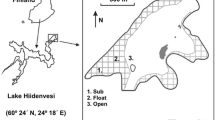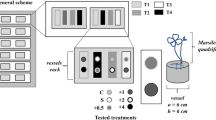Abstract
Release of oxygen from the roots ofaquatic macrophytes into anaerobic sediments canaffect the quantity of interstitial dissolved organicmatter and nutrients that are available to bacteria. Nutrient and dissolved organic carbon (DOC)concentrations were compared between subsurface(interstitial) waters of unvegetated sediments andsediments among stands of the emergent herbaceousmacrophyte Juncus effusus L. in a lotic wetlandecosystem. Concentrations of inorganic nitrogen(NH4 +, NO3 -, and NO2 -)were greater from sediments of the unvegetatedcompared to the vegetated zone. DOC concentrations ofinterstitial waters were greater in sediments of theunvegetated zone both in the winter and springcompared to those from the vegetated zone. AlthoughDOC concentrations in hydrosoils collected from bothzones increased from winter to spring, bacterialproductivity per mg DOC in spring decreased comparedto winter. Greater initial bacterial productivityoccurred on DOM collected from the vegetated comparedto the unvegetated zone in winter samples (days 1 and4), with increased bacterial productivity on samplescollected from the unvegetated zone at the end of thestudy (day 20). Bacterial productivity wassignificantly greater on all sampling days on DOM fromvegetated samples compared to unvegetated samples. In nutrient enrichment experiments, bacterialproductivity was significantly increased (p < 0.05)with phosphorus but not nitrogen only amendments.
Similar content being viewed by others
References
Armstrong J & Armstrong W (1988) Phragmites australis-A preliminary study of soiloxidizing sites and internal gas transport pathways. New Phytol. 108: 373–382
Bano N, Moran MA & Hudson RE (1997) Bacterial utilization of dissolved humic substances from a freshwater swamp. Aquat. Microb. Ecol. 12: 233–238
Bjørnsen PK & Kuparinen J (1991) Determination of bacterioplankton biomass, net production and growth efficiency in the Southern Ocean. Mar. Ecol. Progr. Ser. 71: 185–194
Boon PI & Sorrell BK (1991) Biogeochemistry of billabong sediments. I. The effect of macrophytes. Freshwat. Biol. 26: 209–226
Boissier JM & Fontvielle D (1993) Biodegradable dissolved organic carbon in seepage waters from two forest soils. Soil Biol. Biochem. 25: 1257–1261
Edwards RT & Meyer JL (1986) Production and turnover of planktonic carbon in two southeastern blackwater rivers. Appl. Environ. Microbiol. 52: 1317–1323
Green MS & Etherington JR (1977) Oxidation of ferrous iron by rice (Oryza sativa L.) roots: A mechanism for waterlogging tolerance? J. Expt. Bot. 28: 678–690
Kirchman DL (1993) Leucine incorporation as a measure of biomass production by heterotrophic bacteria. In: Kemp PF, Sherr BF, Sherr EB & Cole JJ (Eds) Handbook of Methods in Aquatic Microbiology (pp 509–512). Lewis Publishers, Boca Raton, Florida
Koepfler ET, Benner R & Montagna PA (1993) Variability of dissolved organic carbon in sediments of a seagrass bed and an unvegetated area within an estuary in southern Texas. Estuaries 16: 391–404
Laan P, Smolders A, Blom CWPM & Armstrong W (1989) The relative roles of internal aeration, radial oxygen losses, iron exclusion and nutrient balances in flood-tolerance of Rumex species. Acta Bot. Neerl. 38: 131–145
Mann CJ & Wetzel RG (1995) Dissolved organic carbon and its utilization in a riverine wetland ecosystem. Biogeochemistry 31: 99–120
Marksova R (1991) Growth of bacterioplankton on dissolved organic carbon in Hamilton Harbour and western Lake Ontario. Water Poll. Res. J. Can. 26: 173–185
Moore BC, Lafer JE & FunkWH (1994) Influence of aquatic macrophytes on phosphorus and sediment porewater chemistry in a freshwater wetland. Aquat. Bot. 49: 137–148
Penhale PA & Wetzel RG (1983) Structural and functional adaptations of eelgrass (Zostera marina L.) to the anaerobic sediment environment. Can. J. Bot. 61: 1421–1428
Roden EE& Wetzel RG (1996) Organic carbon oxidation and suppression of methane production by microbial Fe (III) oxide reduction in vegetated and unvegetated freshwater wetland sediments. Limnol. Oceanogr. 41: 1733–1748
Saleque MA & Kirk GJD (1995) Root-induced solubilization of phosphate in the rhizosphere of lowland rice. New Phytol. 129: 325–336
Servais PL, Billen G & Hascoët MC (1987) Determination of the biodegradable fraction of dissolved organic matter in waters. Water Res. 21: 445–450
Servais PL, Anzile A & Ventresque C (1989) Simple method for determination of biodegradable dissolved organic carbon in water. Appl. Environ. Microbiol. 55: 2732–2734
Stanley EH & Ward AK (1997) Inorganic nitrogen regimes in an Alabama wetland. J. N. Am. Benthol. Soc. 16: 820–832
Tranvik LJ (1988) Availability of dissolved organic carbon for planktonic bacteria in oligotrophic lakes of differing humic content. Microb. Ecol. 16: 311–322
Tulonen T, Salonen K & Arvola L (1992) Effects of different molecular weight fractions of dissolved organic matter on the growth of bacteria, algae and protozoa froma highly humic lake. Hydrobiologia 229: 239–252
Wetzel RG & Likens GE (1991) Limnological Analyses 2nd edn. Springer-Verlag, New York
Wetzel RG, Hatcher PG & Bianchi TS (1995) Natural photolysis by ultraviolet irradiance of recalcitrant dissolved organic matter to simple substrates for rapid bacterial metabolism. Limnol. Oceanogr. 40: 1369–1380
Author information
Authors and Affiliations
Corresponding author
Rights and permissions
About this article
Cite this article
Mann, C.J., Wetzel, R.G. Effects of the emergent macrophyte Juncus effusus L. on the chemical composition of interstitial water and bacterial productivity. Biogeochemistry 48, 307–322 (2000). https://doi.org/10.1023/A:1006208213821
Issue Date:
DOI: https://doi.org/10.1023/A:1006208213821




